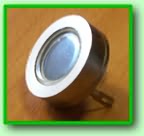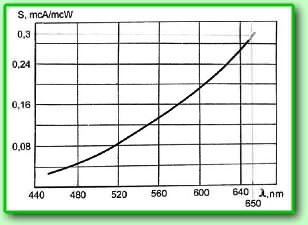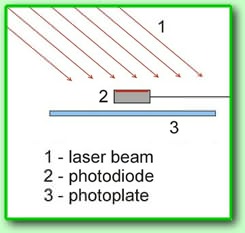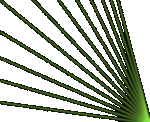|
7. Exposure
All
the holographers familiar with the situation, when
the hologram is not properly exposed - brightness
of the hologram is low, there is a veil on all its
surface etc. We offer the simple and rather precise
method of definition of optimal exposing time of
the hologram. For this purpose it is necessary to
measure illumination intensity E of a photoplate,
see fig. As the hologram is recorded by monochromatic
laser light, the measurements of illumination
intensity are necessary to carry out in energy
units, for example, in mkW/cm2. It is
necessary to refuse usual photometer devices such
as luxmeters, because they are designed for measurements
in white light.
 The silicon photodiodes are
most suitable for measurements in holography, that
have a high light sensitivity, good linearity in
a broad band of photocurrents, big size of a photosensitive
surface, opportunity to work in a photovoltaic mode,
without the power supply. We recommend as a measurer
of a photocurrent the microammeter, that have broad
band of measured currents - from 50 nA up to 50
mA (figure shows FD-7k photodiode, which is popular
in Russia). The special measurings have shown very
good linearity of recording of photocurrents on
all bands for a pair: such special photodiode -
microammeter. It allows one to determine illumination
intensity and, accordingly, the time of exposing
of the hologram depends on value of a photocurrent
under the simple formula with use of scaling coefficient
K. The silicon photodiodes are
most suitable for measurements in holography, that
have a high light sensitivity, good linearity in
a broad band of photocurrents, big size of a photosensitive
surface, opportunity to work in a photovoltaic mode,
without the power supply. We recommend as a measurer
of a photocurrent the microammeter, that have broad
band of measured currents - from 50 nA up to 50
mA (figure shows FD-7k photodiode, which is popular
in Russia). The special measurings have shown very
good linearity of recording of photocurrents on
all bands for a pair: such special photodiode -
microammeter. It allows one to determine illumination
intensity and, accordingly, the time of exposing
of the hologram depends on value of a photocurrent
under the simple formula with use of scaling coefficient
K.
 Figure shows the diagram of
relationship between sensitivity S(l) and wave length
for the special photodiode, which is recorded in
a band of wave lengths including the basic line
of generation of lasers: 488 nm, 514 nm and 633
nm.Scaling coefficient can be calculated from the
expression: Figure shows the diagram of
relationship between sensitivity S(l) and wave length
for the special photodiode, which is recorded in
a band of wave lengths including the basic line
of generation of lasers: 488 nm, 514 nm and 633
nm.Scaling coefficient can be calculated from the
expression:
K = 1/S(l)*A, mkW/(mkA*cm2),
Where
S(l) is spectral sensitivity of the photodiode,
mkA/mkW, A - photosensitive surface of the photodiode,
cm2.
There
are the coefficients in the table below, that are
calculated for three wave lengths of the laser at
a diameter of a diaphragm on the surface of the
photodiode 3 mm. The complete diameter of a photosensitive
surface of the photodiode is equal 8 mm and it not
always suitable for precise measurements of illumination
intensity from an object beam.
| Wave
length, nm |
S(l) |
K |
|
488
|
0.05
|
280
|
|
514
|
0.08
|
170
|
|
633
|
0.25
|
50
|
The
determination of illumination intensity of a photoplate
E is multiplication of value of a photocurrent I,
measured in mkA on scaling coefficient K.
E = K*I, mkW/cm2
The
exposing time T corresponding to necessary sensitivity
of a photoplate S, mkJ/cm2, is determined
by the formula:
T = S/E, s
Sensitivity
S is mentioned on a label of a box with photoplates
(see Lesson 2).
Let's
consider concrete example for our recording scheme.
We use the photoplate PFG-03 with energy of exposing
1000 mkJ/cm2.
The
measurement at a centre of the photoplate gives
the value of a photocurrent - 3 mkA. We multiply
this value on scaling coefficient (50) for a wave
length 633 nm and it gains illumination intensity
of photoplate:
E = 3*50 = 150
mkW/cm2
Next,
we divide known value of exposing energy for photoplates
PFG-03 by the received value of illumination intensity
and it gives required time of exposing:
1000 (mkJ/cm2)/150
(mkW/cm2) = 7 s
The
received time of exposing is optimum time for this
illumination intensity of a photoplate PFG-03.
In
summary we give several concrete recommendations:
-
 Find out beforehand the optimum
energy of exposing for photoplates from the
manufacturer, if it's not written on a box. Find out beforehand the optimum
energy of exposing for photoplates from the
manufacturer, if it's not written on a box.
-
Hold a photosensitive surface
of the photodiode in a parallel plane of a photoplate
(see fig.) and closer to it, if possible. Otherwise
value of illumination intensity will be measured
incorrectly.
-
Keep uniformity of a beam
on surface of a photoplate. More than 30% from
illumination intensity at centre does not suppose
wane of illumination intensity on edges of a
photoplate. It is possible to do these measurements
with the help of the photodiode - just on value
of a photocurrent. Do not rely on your eyes
- they can't compare soft illumination intensities.
-
Try to test linearity of measurements
of a photocurrent. For this purpose find a neutral
light filter with well-known multiple factor
of absorption (for example, 2 or 3). Measure
the illumination intensity by the photodiode,
then put the light filter in front of the photodiode
(plane of a filter should be perpendicular to
the direction of light). If a measurement is
linear, a photocurrent will reduce by the same
value. Otherwise, a photocurrent will reduce
by a lesser value. In this case a measurement
is nonlinear, use a microammeter with a lesser
input resistance.
-
All the measurements should
be carried out in a dark room. -->
|





